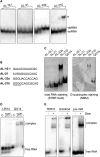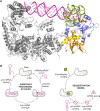RNA and DNA G-quadruplexes bind to human dicer and inhibit its activity
- PMID: 33733306
- PMCID: PMC8038994
- DOI: 10.1007/s00018-021-03795-w
RNA and DNA G-quadruplexes bind to human dicer and inhibit its activity
Abstract
Guanine (G)-rich single-stranded nucleic acids can adopt G-quadruplex structures. Accumulating evidence indicates that G-quadruplexes serve important regulatory roles in fundamental biological processes such as DNA replication, transcription, and translation, while aberrant G-quadruplex formation is linked to genome instability and cancer. Understanding the biological functions played by G-quadruplexes requires detailed knowledge of their protein interactome. Here, we report that both RNA and DNA G-quadruplexes are bound by human Dicer in vitro. Using in vitro binding assays, mutation studies, and computational modeling we demonstrate that G-quadruplexes can interact with the Platform-PAZ-Connector helix cassette of Dicer, the region responsible for anchoring microRNA precursors (pre-miRNAs). Consequently, we show that G-quadruplexes efficiently and stably inhibit the cleavage of pre-miRNA by Dicer. Our data highlight the potential of human Dicer for binding of G-quadruplexes and allow us to propose a G-quadruplex-driven sequestration mechanism of Dicer regulation.
Keywords: Dicer PPC cassette; Dicer inhibition; MiRNA biogenesis; PAZ domain; Regulation of enzyme activity; Ribonucleoprotein complexes.
Conflict of interest statement
The authors declare no conflict of interest.
Figures






Similar articles
-
Unknown Areas of Activity of Human Ribonuclease Dicer: A Putative Deoxyribonuclease Activity.Molecules. 2020 Mar 20;25(6):1414. doi: 10.3390/molecules25061414. Molecules. 2020. PMID: 32244942 Free PMC article.
-
The Significance of the DUF283 Domain for the Activity of Human Ribonuclease Dicer.Int J Mol Sci. 2021 Aug 13;22(16):8690. doi: 10.3390/ijms22168690. Int J Mol Sci. 2021. PMID: 34445396 Free PMC article.
-
Xanthone derivatives as potential inhibitors of miRNA processing by human Dicer: targeting secondary structures of pre-miRNA by small molecules.Bioorg Med Chem Lett. 2013 Jan 1;23(1):252-5. doi: 10.1016/j.bmcl.2012.10.108. Epub 2012 Nov 2. Bioorg Med Chem Lett. 2013. PMID: 23164709
-
To unwind the biological knots: The DNA/RNA G-quadruplex resolvase RHAU (DHX36) in development and disease.Animal Model Exp Med. 2022 Dec;5(6):542-549. doi: 10.1002/ame2.12251. Epub 2022 Jul 4. Animal Model Exp Med. 2022. PMID: 35789129 Free PMC article. Review.
-
The many faces of Dicer: the complexity of the mechanisms regulating Dicer gene expression and enzyme activities.Nucleic Acids Res. 2015 May 19;43(9):4365-80. doi: 10.1093/nar/gkv328. Epub 2015 Apr 16. Nucleic Acids Res. 2015. PMID: 25883138 Free PMC article. Review.
Cited by
-
3D Modeling of Non-coding RNA Interactions.Adv Exp Med Biol. 2022;1385:281-317. doi: 10.1007/978-3-031-08356-3_11. Adv Exp Med Biol. 2022. PMID: 36352219
-
Revisiting Two Decades of Research Focused on Targeting APE1 for Cancer Therapy: The Pros and Cons.Cells. 2023 Jul 20;12(14):1895. doi: 10.3390/cells12141895. Cells. 2023. PMID: 37508559 Free PMC article. Review.
-
Optical Probes for Cellular Imaging of G-quadruplexes: Beyond Fluorescence Intensity Probes.Angew Chem Int Ed Engl. 2025 May 26;64(22):e202424931. doi: 10.1002/anie.202424931. Epub 2025 Apr 21. Angew Chem Int Ed Engl. 2025. PMID: 40192564 Free PMC article. Review.
-
Impact of a Single Nucleotide Change or Non-Nucleoside Modifications in G-Rich Region on the Quadruplex-Duplex Hybrid Formation.Biomolecules. 2021 Aug 18;11(8):1236. doi: 10.3390/biom11081236. Biomolecules. 2021. PMID: 34439902 Free PMC article.
-
Possible role of human ribonuclease dicer in the regulation of R loops.FEBS Open Bio. 2025 Sep;15(9):1406-1418. doi: 10.1002/2211-5463.70026. Epub 2025 Mar 24. FEBS Open Bio. 2025. PMID: 40127989 Free PMC article. Review.
References
MeSH terms
Substances
Grants and funding
LinkOut - more resources
Full Text Sources
Other Literature Sources

